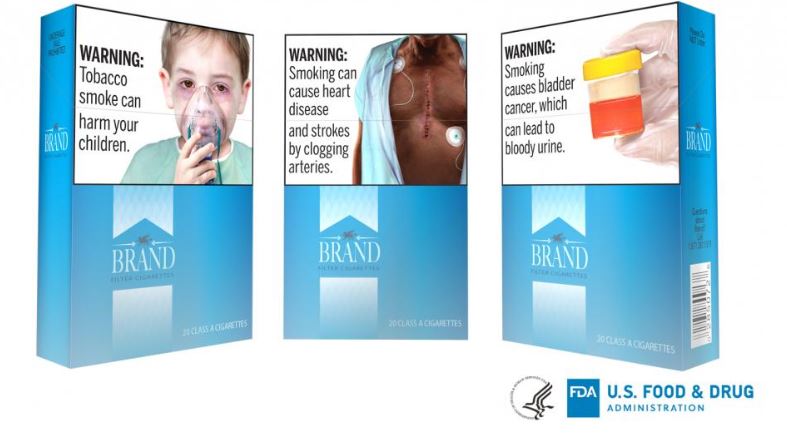
New required health warnings with color images for cigarette packages and advertisements to promote greater public understanding of negative health consequences of smoking
Science-based approach to develop and evaluate the new proposed cigarette health warnings
- Focus on serious health risks – such as bladder cancer, diabetes, erectile dysfunction and conditions that can cause blindness
 Federal and CDC collaboration to investigate respiratory illnesses reported after use of e-cigarette products
Federal and CDC collaboration to investigate respiratory illnesses reported after use of e-cigarette products
FDA and CDC collaborating to investigate incidents of severe respiratory disease associated with use of e-cigarette products
- Updating the number of potential cases of respiratory illnesses after use of e-cigarette products
- Sharing more details about CDC and FDA work
- Providing public and health partners across the country with information to help mitigate risk of additional incidents
More information needed to better understand relationship between specific products and reported illnesses
- THC and cannabinoids use reported in many cases
- e-cigarette products should not be used by youth, young adults, pregnant women, and adults who do not currently use tobacco products
 Transition to Duodenoscopes with Innovative Designs to Enhance Safety
Transition to Duodenoscopes with Innovative Designs to Enhance Safety
- Duodenoscopes used in more than 500,000 endoscopic retrograde cholangiopancreatography (ERCP) procedures each year
- Have complex designs with reusable hard-to-clean components
- Failure to correctly reprocess duodenoscope could result in patient-to-patient disease transmission
- Recommendation to use duodenoscopes with innovative device designs that make reprocessing easier, more effective, or unnecessary. (e.g. Fujifilm Corporation, Duodenoscope model ED-580XT, Pentax Medical, Duodenoscope model ED34-i10T)

Consideration of Uncertainty in Making Benefit-Risk Determinations in Medical Device Premarket Approvals, De Novo Classifications, and Humanitarian Device Exemptions
In premarket decision-making for devices, there exists some uncertainty around benefits and risks – type, magnitude, duration, frequency, other aspects
Appropriate uncertainty in a benefit-risk determination would depend on totality of information covering several factors
- Extent of probable benefits of the device – magnitude, probability, duration, frequency
- Extent of probable risks of the device- severity, type, number, rates, probability, duration
- Extent of uncertainty of benefit-risk profile of precedent devices
- Patients’ perspective on appropriate uncertainty
- Extent of the public health need
- Feasibility of generating extensive premarket clinical evidence
- Ability to reduce or resolve remaining uncertainty postmarket
- Effectiveness of mitigations, such as labeling, and other tools
- Type of decision being made (e.g., HDE vs PMA)
- Probable benefits of earlier patient access to the device

Factors to Consider When Making Benefit-Risk Determinations in Medical Device Premarket Approval and De Novo Classifications

Male Breast Cancer: Developing Drugs for Treatment
Breast cancer is rare in males (<0.1%), diagnosed at an older age, with more advanced stage of disease, and more likely to have lymph node involvement
- Eligibility criteria for clinical trials of breast cancer drugs should allow for inclusion of both males and females
- May be possible to extrapolate findings to male patients where no difference in efficacy or safety between males and females is anticipated

Delivering Promising New Medicines Without Sacrificing Safety and Efficacy
Congress has established five programs to expedite patient access to drugs that treat serious or life-threatening conditions while maintaining FDA’s gold standard of safety and efficacy
To assist drug development
- Fast Track designation: Drug is intended to treat a serious disease and that laboratory, animal model, or human data show promise
- Breakthrough Therapy designation: Preliminary clinical evidence indicates that drug may demonstrate substantial improvement over available therapy
- Regenerative Medicine Advanced Therapy designation (RMAT): Preliminary clinical evidence indicates regenerative medicine therapy has potential to address unmet medical needs for such condition
To expedite FDA review timelines:
- Priority Review designation : FDA aims to take action on a marketing application within six months, compared to 10 months under standard review. Only granted if data submitted in the marketing application appear to show a significant improvement in safety or effectiveness for a serious condition
Different route for expediting:
- Accelerated Approval: Approval of a drug that demonstrates an effect on a “surrogate endpoint” that is reasonably likely to predict clinical benefit
Image credit: FDA
